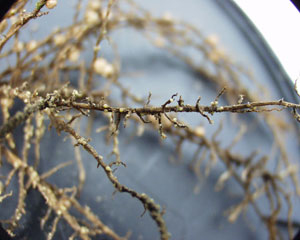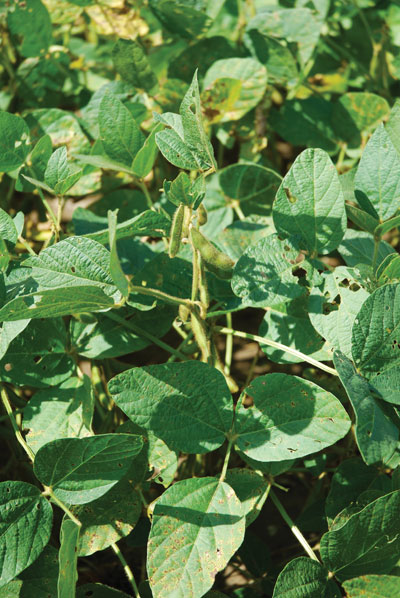
Features
Inoculants
Seed & Chemical
New pest-resistant crop advances from unique partnership
New insect-resistant corn and cyst-nematode resistant soybean varieties are the goal of a research and development partnership between Syngenta Biotechnology Inc. and Athenix Corp., announced earlier in 2008.
November 14, 2008 By Editorial Staff
Resulting corn and soybean will contain insecticidal proteins in the tissues.
 |
|
| Since 2007, soybean cyst nematode has been moving further east across Ontario. |
New insect-resistant corn and cyst-nematode resistant soybean varieties are the goal of a research and development partnership between Syngenta Biotechnology Inc. and Athenix Corp., announced earlier in 2008. Dr. Roger Kemble, head of Crop Genetics Research at Syngenta, says, “The gene leads identified by Athenix, combined with our expertise in transformation and transgenic crop development, will build on our long-term program to offer more competitive choices to growers.”
The collaboration will result in corn and soybean plants with tissues that will contain toxins lethal to many pests. In the case of corn insects, the pests will essentially take one bite and die. These insects include many from the lepidopteran (moth) group, such as European corn borer, corn earworm, fall armyworm, black cutworm, western bean cutworm and sugar cane borer. Several corn rootworm species are also targeted.
In soybeans, the research aims to produce plants resistant to soybean cyst nematode. Typically, the nematode invades the root through the spaces between the cells and establishes a feeding cell or cyst, which protects it from the natural defences of the plant. Kemble says it is much more difficult to kill these pests than those that simply feed on leaf, ear or root tissue in corn.
Stages of the process
The entire research program has been planned by a combined team made up of equal numbers of scientists from Syngenta and Athenix. Stages of the program are then carried forward by team members at each company, according to their areas of scientific expertise.
The process begins at Athenix. Geneticists there are using a novel and proprietary method of identifying bacterial genes that result in toxin production known as the MiDAS Gene Delivery System. Some of the bacteria used belong to the genus Bacillus (of which Bacillus thuringensis is one). They produce toxins which, when ingested by the insect pest, perforate the insect gut wall, causing internal lysing or bursting, and death.
The MiDAS system is a faster, more flexible and more efficient procedure of identifying genes than the standard method. Traditionally, geneticists have discovered bacterial toxin gene sequences by taking individual bacterial colonies and testing the entire colony for its ability to produce a toxin that kills a given target insect. Geneticists identify the toxin and then work to find the gene sequence that results in the production of the toxin. “However, using this traditional method, scientists don’t discover all the useful toxin-producing genes the bacteria may have to offer,” says Kemble. “It’s also very time intensive.”
MiDAS is quite different. This approach has Athenix geneticists starting with the DNA genome of several Bacillus species that they have mapped already from their collection of 22,000 microbial strains. They check these genomes for sequences that are similar to sequences already known to be responsible for toxin production. In the next step, geneticists cut out and insert the target gene sequence into a different bacterial strain to ensure the desired toxin is produced.
Kemble says MiDAS has allowed the identification of a whole collection of related toxins capable of killing insect pests, some of which would have taken a long time to discover and some of which would perhaps have never been discovered otherwise. “This technology enables scientists to discover gene leads which have proven elusive for years, and this will substantially strengthen Syngenta’s long-term pipeline of products,” he says.
Plant transformation
Once Athenix has identified bacterial gene sequences that are confirmed to result in the production of a desired toxin, Syngenta geneticists begin the process of transformation, where the genes are inserted into plants. Kemble says this part of the process is quite complex. “Each gene sequence is different,” he notes. “You never know how it’s going to behave. You want the toxin to be toxic to the pest but not to non-target organisms. Some of these toxins have a toxic breadth that is too great.”

|
|
| Corn rootworm is just one of the species of lepidopteran researchers are hoping to control with new applications. |
In addition, he says “Sometimes these genes don’t result in the production of enough toxin. In that case, we try to increase expression of the gene.” Kemble likens this process of narrowing down these genes to a funnel. “There are many candidate genes and only the very best end up being used,” he says.
Kemble notes there are two approaches to transforming corn. “There are very few inbreds that can be transformed,” he says. “One type is relatively easy to transform and is used widely in laboratory experiments, but its agronomic characteristics are unfavourable.”
The other approach is to find an elite corn inbred with superior growing characteristics that is able to be transformed. This was accomplished by a dedicated Syngenta team which examined dozens of elite hybrid lines and found one that can be transformed routinely. Other inbreds and hybrids are then bred from this line to carry the toxin-producing trait.
The process of creating a commercially available hybrid of toxin-containing corn takes about eight years from first discovering a toxin gene, says Kemble. “From bacterial gene identification to transformed corn, it’s about one year. This is followed by testing the crop on insect species to ensure that the insects you want to be killed die from eating the leaf or root tissue and those you don’t want to be killed don’t die. We also ensure nothing deleterious happens to the plants. There is also the regulatory approval process.”
Under the terms of the agreement, Syngenta can license these “gene transformation events” through further collaborations.
Spraying versus growing future toxin-containing corn hybrids
The benefits of growers using a crop that carries a toxin in its tissues versus spraying a toxin on crops are twofold, according to Kemble. “A spray is active at the time of application and for a time afterward,” he says. “The toxin-carrying corn is economical as the toxin is always there and provides season-long protection.”
Secondly, the transformed corn contains genes that result in the production of at least two toxins with different modes of action that kill the same insect through gut lysing. “The chances of resistance to these two different modes of action are very low,” says Kemble.
Other toxin R&D
When an insect eats a Bt protein, the protein is activated by very specific gut enzymes and becomes a toxin. The toxin then binds to a protein in the wall of the gut called a receptor. When the toxin binds the receptor, it causes the formation of holes in the gut that cause the gut lysing. Many of the Bt toxins currently available bind to the same or similar gut receptors in the target insect so researchers are looking for toxins that work in a different way. “Many people have been looking for over a decade now for microbial toxins that kill insects in different ways, Kemble says. “There have been some advances, but no commercial products to date.”
Syngenta has, however, produced hybrids with vegetative insecticidal proteins technology (VIP), which works in a different way than other Bt toxins currently on the market. These VIPs are produced by bacteria during the vegetative or growth stage of their life cycle, where Bt toxin proteins are produced during the sporulation stage of the cycle. The VIP technology will be commercially available within the next couple of years. “The advantage of having two or more different toxins that kill target insects in different ways is that it will be extremely unlikely that resistance would develop,” says Kemble. Preventing resistance will help protect the technology for use long into the future.
Syngenta also formed a partnership with Chromatin, Inc. in October of 2007, which gives Syngenta the rights to use Chromatin’s “gene stacking technol-ogy” for trait genes in corn and soybeans. This technology potentially offers Syngenta a new method to develop stacked gene products with a higher number of traits than is currently possible. It could speed the time from development to commercialization of stacked trait products, which help growers meet multiple challenges.